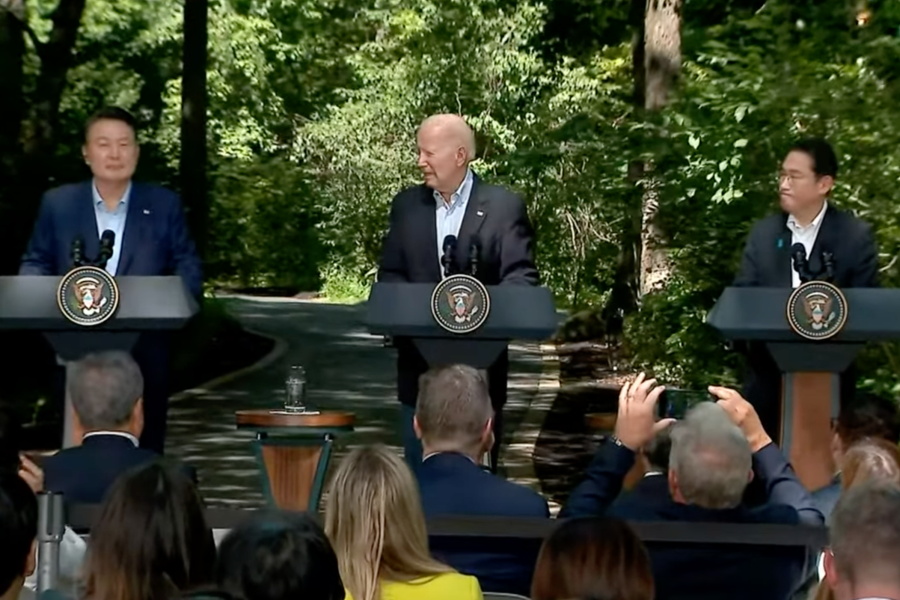The U.S., South Korea, and Japan have committed to sharing real-time missile warning data by the end of 2023, holding annual multi-domain military exercises, and more as part of an historic summit Aug. 18.
U.S. President Joe Biden, Japanese Prime Minister Fumio Kishida, and Republic of Korea (ROK) President Yoon Suk Yeol met at Camp David, Md., for the first ever standalone meeting of the three countries’ leaders and announced a raft of agreements and understandings bolstering their ties in the face of aggression from both China and North Korea.
Among the agreements:
- “We’ve all committed to swiftly consult each other in response to threats against any one of our countries,” Biden said in a press conference. “That means we’ll have a hotline to share information and coordinate our response whenever there’s a crisis in region.”
- The three countries will “activate a data-sharing mechanism to exchange real-time missile warning data,” according to a White House fact sheet, particularly focused on North Korea’s missile launches. The hope is to make that mechanism operational by the end of 2023.
- “Annual, named, multi-domain trilateral exercises,” according to the fact sheet.
- Annual meetings between the countries’ leaders, as well as yearly meetings between their defense ministers and other top-ranking officials, “not just this year, not just next year, but forever, that’s the intention,” Biden said
- A working group between the three countries to combat North Korea’s malicious cyber activities.
- A joint agreement condemning any possible use of military force against Taiwan.
In a press conference, the three leaders tried to emphasize their security commitments go beyond responding to just one country, with Kishida emphasizing the importance of the “rules-based international order” and “regional stability.”
But the threats posed by China and particularly North Korea were common themes.
“We have consulted on practical ways to cooperate aimed at improving our joint response capabilities to North Korea’s nuclear and missile threats, which have become more sophisticated than ever,” Yoon said through a translator.
The agreement for major annual military exercises builds on a previous agreement in January between U.S. Defense Secretary Lloyd J. Austin and South Korean defense minister Lee Jong-sup to ramp up military exercises between the two countries, including more deployments of assets such as fifth-generation fighters and strategic bombers.
In April, Biden and Yoon released a new agreement, dubbed the “Washington Declaration,” aimed at strengthening the U.S.’s commitment to its “extended deterrence” mission—in which America vows to defend South Korea from attack with the full range of its military capabilities, including nuclear weapons. As part of that declaration, the U.S. agreed to make high-profile, but temporary, deployments, of nuclear-capable systems to the Korean peninsula, such as B-52 bombers and nuclear missile submarines.
Japan and the U.S., meanwhile, also stepped up their bilateral exercises in 2022, according to news agency Nikkei, and have conducted exercises every month this year. A U.S. Air Force B-52 briefly landed at Yokota Air Base in July due to an in-flight maintenance issue, and B-1s deployed to Misawa Air Base as part of a Bomber Task Force rotation.
Trilateral exercises have also taken place: in February, April, and July, the three countries combined for naval ballistic missile defense exercises in response to North Korean missile tests.
Trilaterial aerial exercises have been less common to this point, but Pacific Air Forces commander Gen. Kenneth S. Wilsbach told Nikkei in April that he would like to see them occur.
Historically, there has been enmity between Japan and South Korea, hindering cooperation. But at Camp David, Yoon and Kishida presented a united front and pledged to open a “new chapter” in cooperation.
